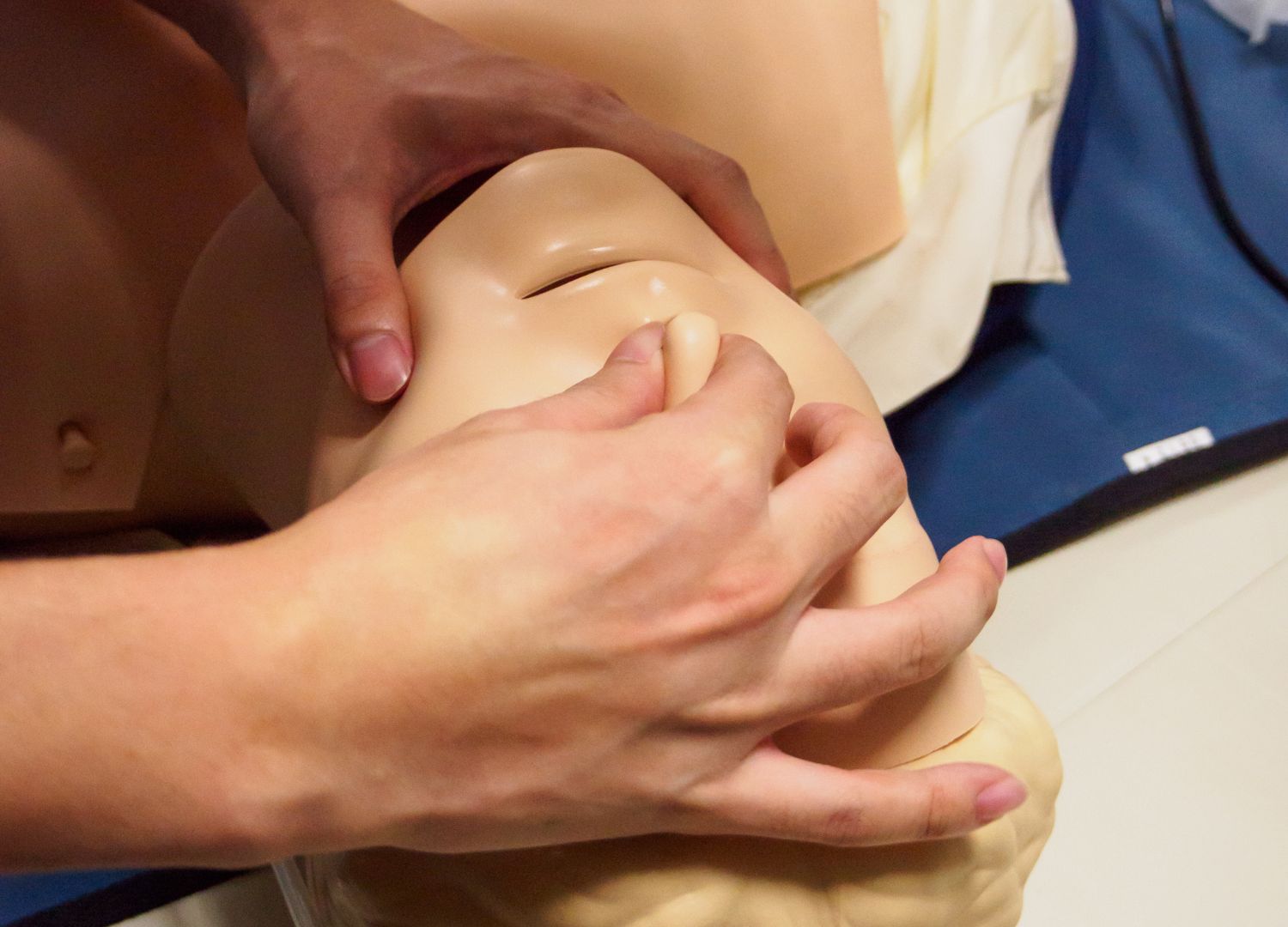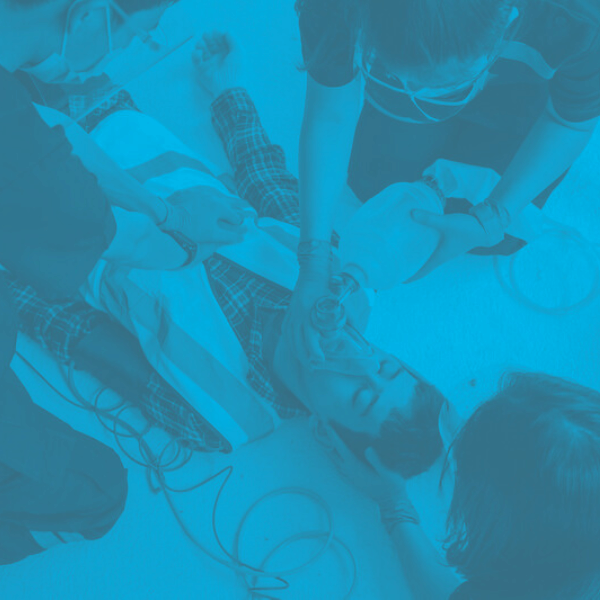How to Perform the Jaw Thrust Maneuver for Airway Management
How to Perform the Jaw Thrust Maneuver for Airway Management

by Greta Kviklyte
Life Saver, AMC
Co-authored by Kim Murray, RN, M.S.
posted on Aug 15, 2024, at 8:33 am
The jaw thrust maneuver is a specific method for opening the airway of an unconscious person. During the process of performing CPR, it is critical to open the airway of the patient to allow for air movement. The typical method of using the head-tilt chin-lift method is not applicable in some situations, especially when a patient’s head cannot be easily moved. Knowing how to use the jaw-thrust maneuver may help to provide your patient with the ability to breathe and keep the airway unobstructed, making it a critical skill to learn.
When Is the Jaw Thrust Maneuver Used?
We offer Online CPR and BLS Certification
The use of the jaw thrust maneuver is necessary when a patient has cervical spine injuries or suspected injuries of the spine. It may be used when a patient is unconscious and has obvious or suspected injuries to the spine or neck.
In patients who are unconscious with a suspected cervical spine injury, the jaw-thrust maneuver is effective at allowing the tongue to be cleared from the airway. It does not require any manipulation of the spine when done properly, as noted by Clinics in Sports Medicine practitioners Mary Terese Whipple MD and Jeffrey P. Feden MD at ScienceDirect.
The jaw thrust maneuver provides for effective management of the airway when a patient is unconscious and should be employed in specific situations when careful airway management is necessary. It is appropriate in most situations, such as the following:
- The patient is unconscious: This is the primary indication of using this technique. The patient is not responsive and not breathing normally, as witnessed in chest movement. Opening the patient’s airway may facilitate effective breathing.
- Spinal or neck injuries or suspected injuries: If there is any potential of a neck or spinal injury, such as when a person suffers serious trauma, falls, or accidents, this method minimizes any movement of the cervical spine to reduce the risk of worsening the injuries.
- Limited mobility of the neck: In situations where it is not possible to move the neck due to a medical condition or other known limitations, this method may be used to open the airway without causing additional harm.
- Facial trauma: A patient with facial trauma or fractures that hinder the use of the head tilt chin lift method may benefit from the use of this method.
In situations where the cause of the person’s consciousness is not fully understood, it may be beneficial to use this method to protect the airway without moving the spine.
How to Perform the Jaw Thrust Maneuver on a Patient
To perform the jaw thrust maneuver, it is critical to get the  position of the patient just right, learn how to place your hands, and the specific technique to use. Consider the following steps to ensure you perform this method properly.
position of the patient just right, learn how to place your hands, and the specific technique to use. Consider the following steps to ensure you perform this method properly.
Positioning the Patient for Care
To perform this method, the patient should be on their back on a firm surface. Avoid moving the patient any more than necessary if there is a suspected spinal injury. A stable platform is necessary for performing this maneuver safely since it limits any unnecessary movement of the body, reducing the risk of more complicated injuries.
Once the patient is in the proper position, kneel next to the patient’s head. Position yourself so that you have a clear view of the airway. This provides better control to the rescuer in performing the maneuver properly. The right position for you also ensures you can monitor the patient closely for any response or changes in vital signs.
Remember:
- Ensure the patient is on a flat, solid surface.
- Position yourself at the head of the person, often kneeling behind their head to gain access.
Hand Placement in the Jaw Thrust Maneuver
The way you place your hands on the patient will determine the effectiveness of this maneuver. Specifically, place both of your hands on either side of the head. Position your fingers under the jawbone at the hinge of the jaw. This allows you to gently lift the jaw. In doing this, you will need a firm grip but not so tight that you cause discomfort or injury to the patient.
- Position your fingers at the hinges of the jaw, with a grasp around the jaw and thumbs positioned just under the lower lip on the chin.
How to Move the Jaw
Once in position, lift the jaw upward and forward using both of your hands at the same time. The goal is to move the jaw away from the face, which allows you to open the airway. It only takes gentle movement to do this, and it allows you to reposition the tongue using your fingers. By seeing directly into the airway, you can also see any tissues blocking the airway and manipulate them enough to open them.
In this process, use your fingers to guide the lower jaw (mandible) forward. This creates a chin-up position, helping to clear the airway of the patient as a result. It is critical not to apply so much pressure or force to this process that it causes significant movement of the neck or head. Gently guide the movement of the jaw instead.
- Apply pressure to the fingers and thumb, lifting the lower jaw slightly upward.
- Open the airway and ensure the tongue is out of the way of the back of the throat and any obstructions are removed.
Assessing a Patient After Manipulation
Once you have moved the patient’s jaw and opened the airway, look at the patient’s chest. Look for any signs of breathing, even limited rise and fall of the chest. If there is no movement, check to ensure nothing is blocking the airway in the mouth. Foreign objects, including debris or vomit, could be in the way, limiting their ability to breathe.
In situations where the patient is not breathing adequately, it is necessary to maintain the maneuver over time until additional help arrives to support the patient’s breathing. Maintaining the airway opening is critical to ensuring the lungs can pull in air if the person is able to do so. In many situations, it then becomes necessary to initiate CPR if a person has not responded on their own.
- Monitor for breathing.
- If there is no breathing, check the mouth again for any obstructions present.
- Call for help if you have not done so yet.
- Provide rescue breathing or CPR, dependent on the patient’s condition
The jaw thrust maneuver is highly effective, but time is critical. Ensure that you practice this method of opening a person’s jaw and positioning your hands so that you gain the muscle memory to act quickly. Accuracy, attention to details of the obstructions in the mouth, and careful monitoring of the patient’s breathing can help you save their life.
How Does the Jaw Thrust Maneuver Differ from the Head Tilt Technique?
The head tilt chin lift maneuver is the standard used in most situations for clearing the obstruction of the patient’s airway. In this method, the person’s head is tilted backward, which automatically opens the airway. This method will involve hyperextension of the neck.
In the jaw-thrust maneuver, the neck is not manipulated in the same manner. Instead, this method forces the jaw forward to open the airway. As a result, this method does not cause the hyperextension of the neck in any way. This maneuver is better in situations where the patient may have a spinal injury.
Jaw-thrust maneuver vs head tilt-chin lift
Jaw thrusts:
- Airway is opened without any movement of the neck
- Use when there could be suspected neck or spinal injury
- Use in trauma patients where injuries to the spine are unsure
- More challenging to perform
- Requires some level of force to move the jaw
- Must be performed properly to be effective
Head tilt chin lift:
- Airway is opened by tilting the head back
- Used when there is no suspected risk of spinal injury
- Use for unresponsive patients when there are no signs of trauma
- More commonly used
- Easier to perform with less overall force
- Effective and ideal for most situations
Both methods take practice to ensure they are done properly. Knowing first aid skills is essential to protecting the patient.
Indications to use Jaw Thrust Maneuver
 The patient has a suspected upper airway obstruction and is unresponsive
The patient has a suspected upper airway obstruction and is unresponsive- Use as a part of initial emergency treatment for patients with impending respiratory arrest
- Use as a part of initial emergency treatment in patients known to have apnea
- Improves airway patency during BVM ventilation and may lead to spontaneous breathing in some situations
Maintain this open airway position as long as necessary while performing other necessary resuscitation tasks or until help arrives.
Contraindications of the Jaw Thrust Maneuver
This method should not be used if the patient has a do-not-resuscitate order or other advanced directives that dictate not performing any life-saving actions.
When determining what is most important, creating and maintaining airway and ventilation is the greater priority over a possible cervical spine injury. When there is any indication of a potential cervical spinal injury, use this method.
The Merck Manual indicates that there are possible complications for this specific airway opening method, including:
- Potential for spinal cord injury if the cervical spine in situations where the cervical spine has an unstable bony or ligamentous injury
- Exacerbation of a mandibular injury
Other potential situations where the jaw thrust maneuver should not be used include:
- Serious facial trauma that indicates mandible injury, which may make the movement impossible
- Jaw fractures in which significant pain may be created, in which situation nasopharyngeal or oropharyngeal airway methods may be better.
- Lack of any mobility of the jaw, which makes this method impossible to complete and may require the use of a laryngeal mask airway or endotracheal intubation
- Maxillofacial surgery patients who have undergone surgery and may have devices or sutures present
- Tracheostomy patients, which is an alternative airway for the patient, and the jaw-thrust maneuver should not be used on
- Patients with neuromuscular disorders such as muscular dystrophy may not have control over jaw movements, which may make this method less effective overall.
Follow Through Care After Performing the Jaw Thrust Maneuver
Once the patient begins to breathe on their own and can clear their airway on their own, you do not have to continue this care. However, maintain the open airway whenever possible for as long as possible.
This method can be applied with the use of oropharyngeal or nasopharyngeal airways. In addition, the use of continuous positive airway pressure may also help to improve airway patency when the manual methods do not work effectively.
It is also possible to use suction to help clear the upper airway. Do so if there is fluid, such as vomiting, that could be obstructing the airway and limiting positive airflow.
The Modified Jaw Thrust Maneuver
A secondary option for rescuers to consider is the modified jaw thrust maneuver which is a simple change in the position of the hands. In th modification, one hand supports the patient’s jaw in the standard method utilized above. The other hand is used to maintain the patient’s head in a neutral position. This creates better protection for the spinal cord in situations where there is a risk of injury.
This method is typically only beneficial when there is evidence of a cervical spine injury because it may be more difficult to perform due to the force needed. In situations where there is a significant cervical injury, use the modified jaw thrust maneuver to hold the head in a neutral position, minimizing any movement. This method maintains spinal precautions.
This method may also be applicable in situations where the patient is conscious but cannot maintain their airway on their own due to muscle weakness or jaw pain. The modified jaw thrust method enables a rescuer to assist the patient in a safe manner and clear their airway without causing significant discomfort or harm to them.
Learn the Necessary Skills to Save Lives
The jaw thrust maneuver is one of the numerous life-saving skills people should know in order to provide patients with the care they need in an emergency situation. This method requires practice and skill to be performed in a safe manner. Getting that training can help ensure you know what to do when there is an emergency in a patient with a suspected spinal cord injury.
At Advanced Medical Certification, we offer comprehensive education and training to equip you with life saving skills. Whether you are a health care provider or an employer, our certification in CPR, AED, and First Aid will prepare you to handle emergencies effectively. Explore our certification options today and start enhancing your emergency response capabilities.



